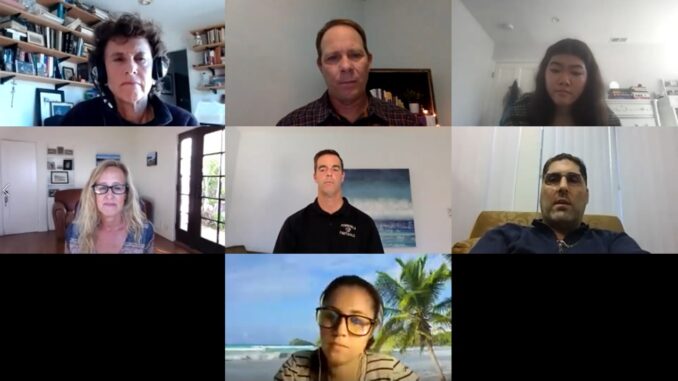
By Fraser Perkins and Ann Nye —
On February 21st the Palos Verdes Democrats met remotely for a panel discussion entitled Connection Before Content – What Is Working Well With Online Learning.
The panelists were:
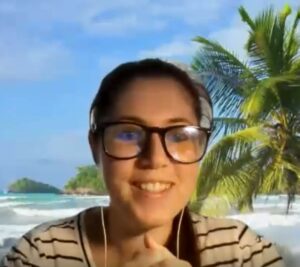 Megan Crawford, a Palos Verdes Unified School District (PVPUSD) board member and a Parras Middle School 6th grade science teacher, who also teaches a cooking elective, Good Eats, in the Redondo Beach Unified School District.
Megan Crawford, a Palos Verdes Unified School District (PVPUSD) board member and a Parras Middle School 6th grade science teacher, who also teaches a cooking elective, Good Eats, in the Redondo Beach Unified School District.
 Todd Shadbourne, an Elk Grove Elementary 6th grade teacher (teaches all subjects) in the Elk Grove Unified School District just south of Sacramento.
Todd Shadbourne, an Elk Grove Elementary 6th grade teacher (teaches all subjects) in the Elk Grove Unified School District just south of Sacramento.
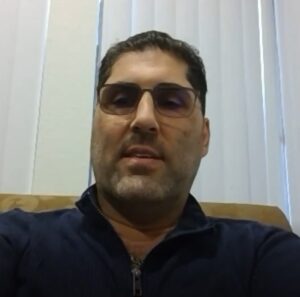 Varo Asorian, a Millikan High School AP (Advanced Placement) economics and marketing teacher in the Long Beach USD.
Varo Asorian, a Millikan High School AP (Advanced Placement) economics and marketing teacher in the Long Beach USD.
 Sarah Liu, a Palos Verdes High School (PVHS) senior and a student board member of the PVPUSD.
Sarah Liu, a Palos Verdes High School (PVHS) senior and a student board member of the PVPUSD.
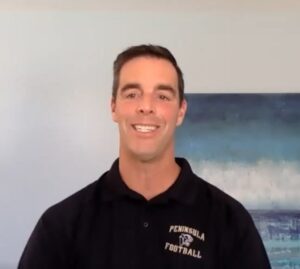 Brent Kuykendall, the principal of Palos Verdes Peninsula High School (PVPHS).
Brent Kuykendall, the principal of Palos Verdes Peninsula High School (PVPHS).
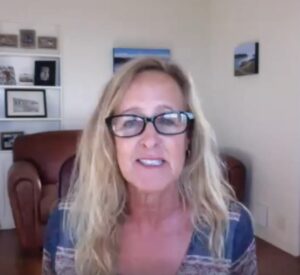 Lisa Larson, a Comprehensive School counselor at Miraleste Intermediate School in the PVPUSD.
Lisa Larson, a Comprehensive School counselor at Miraleste Intermediate School in the PVPUSD.
Ann Nye, PV Dems 2nd VP and moderator of our program, introduced the program emphasizing what we, students, teachers, parents and administrators, all agree on:
-
- We all want to reopen our schools
- We all want to get back to normal-ish
- And, we all are working harder to make virtual and/or hybrid learning work
Ann pointed out what PVPUSD Superintendent Dr. Alex Cherniss said in his Feb. 3rd email message, “It is our hope that the vaccination of people in Tiers 1A and 1B, along with a decrease in COVID transmission rates, will incentivize the county to reopen all schools as soon as possible.” Dr. Cherniss also claimed, “Students whose families chose our Distance Learning Academies, comprised of roughly 25% of our total district population, are thriving. Diagnostic data shows that most of our students are learning at or above grade level despite this new way of learning, which is a tribute to our teachers, our parents, and most importantly our amazing students, who have adapted and succeeded in this very different learning environment.”
The program began with each of our six panelists providing a short summary of their experiences with online learning and the new technology challenges.
Todd, son of PV Dems Treasurer Al Shadbourne, highlighted how the pandemic forced him to become more tech savvy. “When I come back, I think it’s going to be a part of teaching for the remainder of my career.” He also noted that he has a better connection with his students’ families. “I know my parents this year more than I’ve ever known them.” One technique Todd uses is to schedule daily office hours from 2:45–3:15 pm open to both parents and students.
Megan says “the connection piece [in Connection before Content approach] is about teachers connecting with students, but also the students connecting with each other.” She uses the feature of breakout rooms on Zoom, to enable student-to-student connections. Her Parras Middle School in Redondo Beach transitioned to a Block Schedule, where all classes do not meet every day, except for Mondays, when all classes meet. With this change, the school has used Mondays to concentrate on mental health/wellness activities and provide the students a preview of their week’s work without assigning homework. She said, “this focus on connection, which has always been there, but with online learning has been more pronounced, needs to continue after online learning ends.” Megan emphasized the teacher-student connection as the foundation for learning. She noted that PVPUSD presented an Independent Learning option for families in elementary school to home school their kids and check in once or twice per week with their child’s teacher. Megan says this Independent Learning option has the potential to continue after return to in-person learning. Distance Learning (aka on-line learning) may continue in future years, too, since they’ve found that some students thrive in that model.
Varo observed that some students who struggled with in-person learning thrived with online instruction. He ascribed this to no distractions and sufficient time for students to complete their work. Long Beach USD presents education in a normal 7:50 to 2:40 pm school day format. Initially a little uncertain with the format, he feels this approach worked and a structured class day is overall positive. The biggest struggle is to motivate some of his students to do their work in class. He has swapped a daily in-person greeting at the start of each class with taking roll call and engaging with each student before he begins teaching. He sums up his experience: “Kids can thrive online if you hold them to high expectations.”
Working alongside Superintendent Dr. Alex Cherniss, Sarah and her PVPHS counterpart, created a student committee of 30 students from both PVHS and PVPHS and developed The One Hill Project Best Practices list. This project gave students a voice to improve their overall student experience in this pandemic distance learning era. Sarah summarized the project’s findings for us:
- Helpful Practices:
- Small breaks between activities
- Using break-out rooms to increase student interactions
- Encouraging open conversation
- Providing a safe space for feedback
- Changing the timing of homework from due the night before, to due before class
- Generating creative ways of teaching, like using this online quiz game called Kahoots
- Assigning groups when students are not familiar with their peers
- Promoting mental health by checking in with students
- Using “Chat” to remind students of available resources needed to complete projects
- Unhelpful Practices:
- Calling on students – increases social anxiety
- Extending class into passing breaks [aka the transition time between classes]
- Staying on video calls to do work which can be done independently
Sarah said this project allowed students to provide feedback virtually via surveys about their online learning experience, which she was able to share at the PVPUSD board meetings. “Getting that feedback out to the public, to the parents, teachers and the Board, has been super important. The opportunity to give students a voice has worked well with online learning.” Personally, Sarah said she, “found that homework can be a little confusing, but her teachers have been super understanding.”
Brent stated, “This pandemic has been hands down the most difficult thing I and every educator have ever faced. …The only reason for our success is first and foremost for our teachers. They have had to relearn how to teach.”..The pandemic has taken away how students interact with other students, says Brent, and he noted that everyone has put in time and a half to get three quarters out, but cited many reasons for optimism:
-
- The vaccine roll-out
- Teachers learning tech skills
- Quick homework turn-around time
- Presentation of guest speakers from around the world
- Recording of lessons for later availability
- Flexibility of time to turn in homework
The transition to in-person learning, says Brent, is exciting, but will be complicated by mask usage and social distancing on campus. Currently there are student events on campus and last Friday, Brent said, “We had over 800 students on campus, athletic wise, and it was invigorating. But, there is a balance there of making sure people are building those connections, but also staying safe.”
Lisa reflected, “We created a lot of counseling lessons that were based on keeping the connections.” To check-in with our students, “we send out forms every two weeks that pose a variety of questions and we’re getting a response from over 98% of our students.” While tech issues were an initial problem, the challenge of maintaining connections has become more prominent. Lisa says, “teachers have done a phenomenal job” creating their own check-ins and connections with students.” Middle schoolers in general, she says, are shy speaking up in class, and with online learning they are very camera shy. Lisa says we are trying to celebrate the skills they are learning, like time management without a bell system, and organization. They’ve launched lots of lessons and counseling through Zoom to identify student needs.
Moderator Ann Nye prefaced the Q&A Session by noting that Peninsula HS’s Academic Decathlon team earned 2nd place the day before our meeting. Brent said without the worry of traveling all over the place to competitions, more of our high school students have participated virtually in competitions like Academic Decathlon, Model United Nations and Speech and Debate.
Brent queried his fellow panelists, “What have you been most proud of that you have learned?”
Varo responded that Long Beach USD invested in “Canvas”, a learning management system that will handle everything from student’s work to attendance in one comprehensive program. Todd said Canvas is the platform they use in the community college system, too, which is a great transition for high school students.
Audience Q&A
How do the teachers feel about returning to in-person learning without the opportunity to be vaccinated?
Megan responded, “Redondo Beach through 6th grade will be returning to school March 9th. … Anyone might be a little hesitant.” She was personally looking forward to having access to the vaccine starting March 1st. “It is going to be scary, but I will be back to school on March 9th no matter what happens.”
Varo reported that fortunately he lives in Long Beach, which has prioritized vaccines for teachers and they’ve been offering vaccines for the last 30 days and they have vaccinated about two to three thousand of the staff at Long Beach USD. “I got my first vaccine on Friday and my next vaccine is March 19th.” Long Beach plans to open for grades K-5 on March 26th and then bring back seniors first in April so they can experience their last months on campus. Varo says some of his students are not excited about Zooming from the classroom if it’s going to be a hybrid solution with not everyone back in the classroom. They’d rather just stay at home and online. Varo said, “I’m less apprehensive now that I’m going to be vaccinated,” sharing “I had COVID in January and it’s not a pleasant experience.”
Todd said, “Everyone in Elk Grove has had the opportunity to be vaccinated in the last few weeks.” He had his first vaccine 3 weeks ago. They don’t come back to school until the end of March and it will be a hybrid model where “some students come back Monday and Wednesday, others come back Tuesday and Thursday, and Friday is distance learning for everyone.” This type of model may continue next year and parents are being given the option to have their child stay in distance learning now and in the next school year. Of his class of 30 students, “only four students want to come back to the hybrid model.”
Lisa reported that students have shown great responsibility in regard to masks and social distancing on campus and said, “I’m comfortable going back.”
Parents have expressed concerns that there are significant learning gaps resulting from online teaching. What steps will be taken to assess those gaps and what kind of remediation do you anticipate implementing?
Brent, speaking for both PVPHS and PVHS says “we are using a common assessment tool, iReady, which has its proponents and detractors. Palos Verdes is fortunate that most students have access to WiFi, get a device from school and have access to their education. “The learning gap is real,” but maybe in Palos Verdes and the South Bay communities it’s not as significant.
Varo says Long Beach is a very diverse district. He believes that they are having good results at Milliken HS, however the biggest struggle is to get kids to do the work. “Ultimately, kids are resilient.”
Megan said from the Redondo Beach perspective, that, for example, math teachers traditionally look back and review the previous year’s standards with the students before proceeding to teach the new material. She sees this type of assessment continuing (no matter the subject) and it just may need a little more work.
How do educators deal with parent over-involvement?
Todd acknowledged that there is no simple answer. “I am grateful for parent involvement.” If it’s clear the work can be found on Google or that the parents may have done the work, then I may have a conversation with the student. However, in the end, “a parent is a resource and I need to train them on how to use that resource appropriately.”
Brent felt this was not a widespread problem, and would work with the parents should this issue arise. “Virtually, the discussion does feel different,” but it is the same discussion we would have if they were in the classroom.
Varo has not seen this, but much of his class is project based and in-class work on Zoom. “You can’t control the things you can’t control otherwise everyone is going to pull their hair out.” [Editor’s Note: on our Zoom’s Chat there were comments that most parents wouldn’t be able to help their kids in Varo’s classes.]
How are the panelists going to handle the hybrid setting when you return to school?
Todd presented the challenge of simultaneously dealing with remote and in-person teaching. “It’s double the work.” “I’ll have my headset on and I’ll be watching my in-person students, who won’t be watching Netflix, but who knows about the ones at home.” The ones in class have to be 6 feet apart and can’t be in small groups. The difference is they leave before lunch at 12:30 pm and work independently at home until 2:30 pm. Todd plans to use the afternoon time when students are working independently to reach out virtually over Zoom to individual students or groups of students who are struggling with a particular subject. [Editor’s Note: independent learning is called asynchronous instruction.]
Varo says the way we are learning now won’t change that much, but I may be able to give extra attention to the kids who come back to my class and are struggling to keep up. “Kids want normal school and when I tell them what it’s going to be like, they get sad.” In this transition, Varo says, “there’s just a lot of unknowns.”
Megan says their Redondo and PV hybrid model is different, since half the elementary students come in the morning and the other half come in the afternoon. Those that are home are working independently (aka working asynchronously) and may be performing “enrichment” type of activities (like music or art). So, the teacher is only working with the students who are in front of them at that time. For the higher grades, Megan says, we’re not sure what a return to class will look like, but we should know next week.
How do you plan to handle student’s transition between elementary and middle school and middle school to high school?
Lisa reported that graduating 5th grade students view a virtual tour of her school and receive an on-campus tour, observing COVID protocols, when they enter 6th grade. Middle schools have Web, a group which includes selected and trained 8th grade mentors to connect with and host activities with incoming 6th graders.
Brent says the high schools have Link Crew which includes Junior and Senior leadership type students that are paired up with incoming 9th graders. They are already hosting virtual “meet-ups” with incoming freshmen. Brent said, “We won’t be typically having a whole school assembly and I don’t see it happening soon.”
Sarah says her brothers are freshman in high school and she saw what it was like for them to start school virtually. Link Crew has always been out in full force and now they make a point to call every home and introduce themselves and provide support. “The freshman and incoming 6th graders,” says Sarah, “are definitely going to be in good hands.”
How’s the college application process going?
Brent noted that some institutions don’t require tests for admission; colleges have gone from test optional to test blind. Test optional means colleges provide the option for submitting ACT or SAT test scores and just go by the student’s transcript and college application. Test blind, which Brent supports, means the school doesn’t look at ACT or SAT scores at all and he thinks, “the college application process is going to change forever.” Even AP (Advanced Placement) testing, according to Brent, has changed and all tests this past year were taken virtually. It’s still too early to tell, but, he says, “I haven’t seen any change in the data” and added, “students are applying to schools just like they always have and colleges still needs students.”
Sarah said this new testing policy from different colleges has been confusing for seniors. But, she added “the College and Career Centers at both PV and PEN have been doing a great job and that all the seniors are informed of the different options regarding testing and helped with essay writing.” She exclaimed that some students have driven to Utah to take the ACT standardized test and this “shouldn’t be a thing.” Doing away with standardized tests, she concluded, “is definitely a step in the right direction.”
Brent added that both high school College and Career Centers have joined together to provide virtual sessions and the attendance has quadrupled this year. Because of the virtual access, more parents are able to take advantage of the informational sessions at home.
Sarah says “we’ve had financial aid workshops” and workshops that walk you through every step of the college application process.
How do teachers do tests virtually?
Varo responded that most of his class assignments was project based. Ultimately, when the students take the AP test, he will know how they did.
Lisa commented that students who take the assessments online have to submit their work on how they arrived at their answer. This helps the teachers know they understand the steps.
Todd pointed out that the technology has allowed him to customize tests online for different students.
Megan echoed what Varo pointed out that there is only so much we can control. In her grade they have gravitated to open-note assessments and rewarding students who are taking notes, and says the open note option may continue in the future. Her school doesn’t require that cameras are on so they don’t know if someone else is in the room helping, but, Megan says, “we encourage honesty and for students to try their best.” They also allow students to improve their score by re-taking a test.
Ann finished by asking each panelist for some parting thoughts.
Todd was uplifted to see so many people here on a Sunday afternoon and said, “it’s comforting to see colleagues and administrators working together.” [Editor’s Note: during his remarks, Todd’s Zoom froze!] When he returned, he said today’s meeting “was like a good energy drink for a week.”
Sarah was proud of how students showed resiliency and collaborated so well together. The silver lining is, “we’re a lot more smart and creative than we once thought we were.”
Lisa said the collaboration and support of everyone are her positive takeaways. “I’m seeing the good side of people right now and how much they are really helping each other.”
Megan viewed the ability of a district to support educational options like distance learning in the future as positive. This will accommodate families to stay in our district.
Varo saw the year as an opportunity for collaboration. He said, Sarah, “I took good notes when you were speaking, “because I want to make sure I’m reaching my students better.
Brent says “education will never be the same.” As of last March, Brent said, “the world has been turned upside down,” but he believes there will be new approaches and platforms we can use in the future and it will be vital to focus on what you can control, and assume everyone has the best intentions.

Leave a Reply